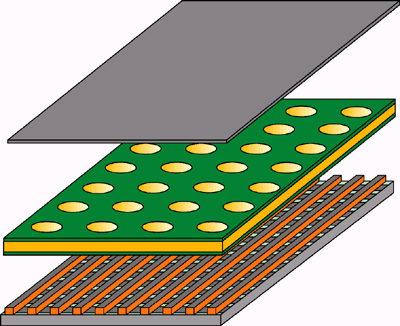A particle detection technique developed at CERN promises increased performance for major new physics experiments or anywhere where the detection of charged particles is needed, such as radiography and medical diagnosis.

As physics experiments get more ambitious, the detectors they use have to keep pace in 1913 Geiger counters, in 1968 Georges Charpak’s multiwire chambers, and more recently, Anton Oed’s microstrip gas chambers. However, the name of the game is always the same to collect and to amplify the electrons knocked out of a gas by charged particles as they pass through.
A new idea, the gas electron multiplier GEM from Fabio Sauli at CERN, continues this tradition. Developed as a way of boosting the performance of microstrip gas chambers, GEMs could soon come into their own.

The objective is to match the harsh running conditions in future experiments, such as those at CERN’s LHC collider, where detectors will have to cope with high data rates and will be exposed to intense bombardment by high-energy particles.
Microstrip gas chambers achieve high precision and high rate by emulating the field structure of multiwire chambers using a sequence of alternating anode and cathode strips on an insulating support. Using photolithography instead of physical wires, the distance between sensitive elements can be reduced to a fraction of a millimetre. A separate electrode gives a drift field to move the electrons towards the amplifying plate.
Increasing the amplification in a microstrip gas chamber to achieve a bigger signal means increasing the operating voltage, but this cannot be continued indefinitely. The energy lost as ionization by charged particles decreases with energy, high energy “minimum ionizing” particles producing relatively small numbers of electrons. High gains are needed to pick up these signals. At these levels, collision by-products such as heavy, slower particles can release substantial additional ionization, resulting in a discharge which could ruin delicate instrumentation.
Chemical piercing
A new solution is GEM a thin sheet of plastic coated with metal on both sides and chemically pierced by a regular array of holes a fraction of a millimetre across and apart. Applying a voltage (about 500 V on 50 microns) across the GEM conducting layers, the resulting high electric field in the holes makes an avalanche of ions and electrons pour through each. The electrons are collected by a suitable device, such as a microstrip gas chamber.
The idea, proposed two years ago, has now been consolidated by development work to produce the GEM sheets with their micro-holes regularly spaced. This know-how was perfected in CERN’s workshops. The resulting GEM layers look like metallic plastic, but are transparent when held up to the light.

The first application of GEM will be in the HERA-B experiment at the HERA electronproton collider at the DESY laboratory in Hamburg,
where GEMs will complement the experiment’s microstrip gas chambers. Several hundred GEM sheets will be supplied by CERN. This approach is also the baseline design for the LHCb experiment at CERN.
Even with a moderate GEM gain, around 30 for HERA-B, the microstrip gas chamber can be operated at a much lower gain, requiring less voltage and therefore being less susceptible to breakdown. However, the overall gain of the tandem device is still optimal.
Sturdier devices have been developed based on a single high gain GEM with printed circuit board readout (where a discharge does less damage), and double GEM configurations with printed circuit board readout where the discharge probability is almost zero. This has been adopted for the small angle tracker of the forthcoming COMPASS experiment at CERN (May 1997).
Several other groups are currently investigating GEM solutions, looking at different configurations, geometries, operating conditions, gas filling etc.
With high gains obtained in purified gases, another possible application is large area photomultipliers capable of picking up single photons. Development in this direction is in collaboration with Israel’s Weizmann Institute and the Budker Institute, Novosibirsk.
GEM-based detectors, like other micro-pattern devices, offer localization to around 40 microns. However, their unique feature is that two co-ordinates can be recorded on the pickup electrode, manufactured using GEM technology. Both x- and y-strips are at ground potential, essential when using high-density readout. Such two-dimensional localization, useful in particle tracking, is necessary for medical imaging.







